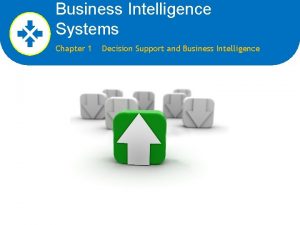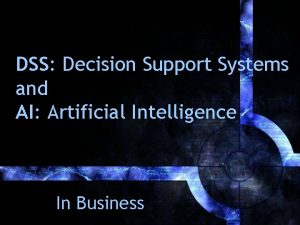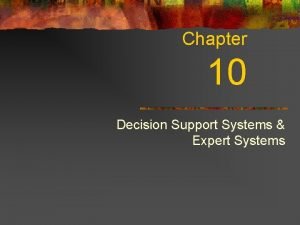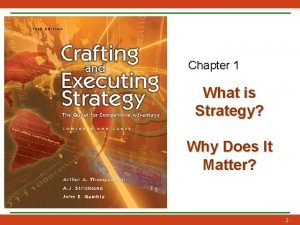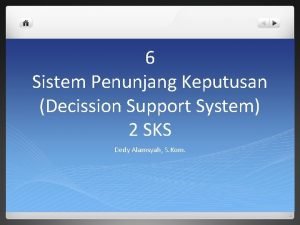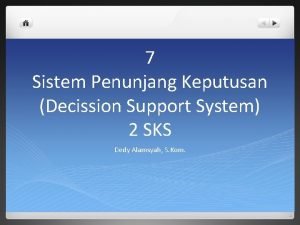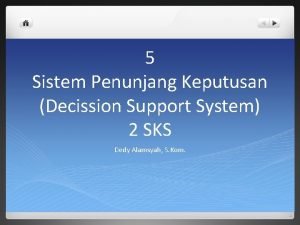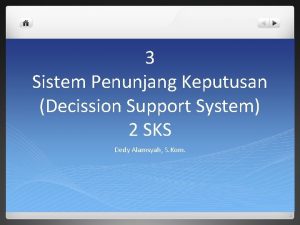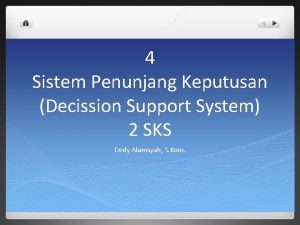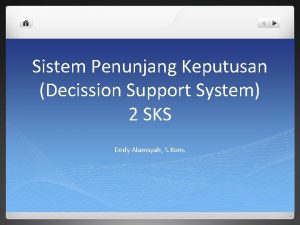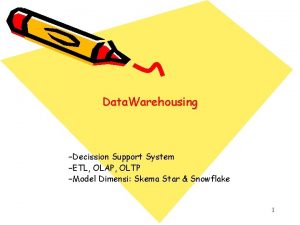DECISSION SUPPORT SYSTEM DECISSION MAKING PROCESS CHOICE INTELLIGENCE















- Slides: 15

DECISSION SUPPORT SYSTEM

DECISSION MAKING PROCESS CHOICE INTELLIGENCE DESIGN

DECISION o Making decisions concerning complex systems often strains our cognitive capabilities. o Predicting how the system will react to an external manipulation such as a policy decision is often difficult.

PROCESS VIEW OF DECISION MAKING

Decision support system • Decision Support Systems (DSS) are a specific class of computerized information system that supports business and organizational decision-making activities. • A properly designed DSS is an interactive softwarebased system intended to help decision makers compile useful information from raw data, documents, personal knowledge, and/or business models to identify and solve problems and make decisions.

WHY DSS o Because decision-making involves a complex sequence of activities over time, it implies there at least three functions that should be assigned to DSSs: 1) The capability of capturing and saving information from previous activities; 2) Data processing capability; 3) Data retrieval capability.

COMPONENTS OF DSS o There are three fundamental components of DSS : o DATA BASE MANAGEMENT SYSTEM (DBMS) o MODEL BASED MANAGEMENT SYSTEM (MBMS) o DIALOG GENERATION &MANAGEMENT SYSTEM (DGMS)

THE ARCHITECTURE OF DSS

Types of DSS o DS systems can be separated into seven broad categories, each aiding decision making by different methods: o o o o DATA DRIVEN DSS. MODEL-DRIVEN DSS. KNOWLEDGE DRIVEN DSS. DOCUMENT DRIVEN DSS. Communication Driven DSS. INTER & INTRA-ORGANIZATIONAL DSS. NEW BREED OF DSS

PROCESING MODEL FOR DSS DATA KNOWLEDGE DATABASE IN-HOUSE PROPRIETARY DATABASE DSS PROCESSING MODELS EXTERNAL AND INTERNAL ENVIRONMENT FINANCIAL ACOUNTING ECONOMICAL PROCESSING BY MANAGER, USING KNOWLEDGE, EXPERIENCE AND INTUITION QUALITY DECISION


NEW BREEDS OF DSS o HYBRID SYSTEM Eg. -WEB BASED DSS o On-line Analytical Processing (OLAP)

MANAGEMENT REQUIREMENT OF DSS o o o ALLOCATING RESOURCES PREPARING BUDGETS OBSERVATION OF RESULTS EVALUATION OF RESULT MODIFICATION OF ACTIVITES AND RESOURCES

Intangible payoffs DSS ü Improved internal control. ü Enhances long term profitability by improving quality of decision making. ü Faster response to changes in business environment.

Cont …. Ø Better management awareness of internal strength and weaknesses and external threats and opportunities. Ø Allows managers’ to record experience and use it in future for similar scenarios that may arise within the organization.
 Decission making process
Decission making process Decision support system in business intelligence
Decision support system in business intelligence Good choice or bad choice
Good choice or bad choice Making a career choice begins with
Making a career choice begins with Strategy analysis and choice largely involves making
Strategy analysis and choice largely involves making Decision support and business intelligence systems
Decision support and business intelligence systems What is inferring
What is inferring War making and state making as organized crime summary
War making and state making as organized crime summary Major support and minor support
Major support and minor support Expert system vs decision support system
Expert system vs decision support system Ai dss
Ai dss Expert system and decision support system
Expert system and decision support system Process of strategic choice
Process of strategic choice Process choice decision
Process choice decision Process of strategic choice
Process of strategic choice Process choice is demand driven
Process choice is demand driven





